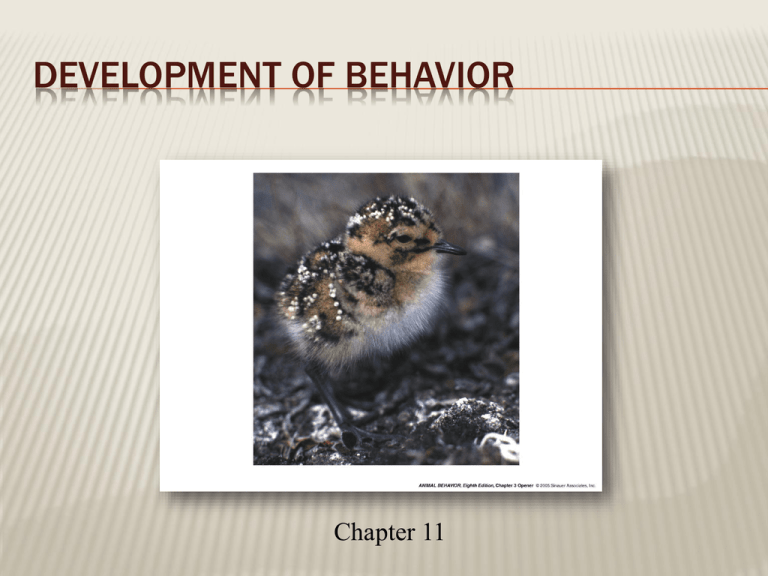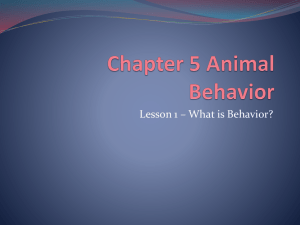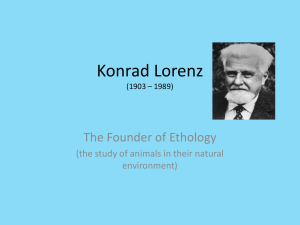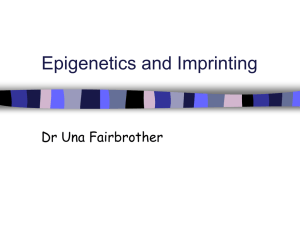
DEVELOPMENT OF BEHAVIOR
Chapter 11
NATURE/ NURTURE MISCONCEPTION
The development of behavior is regulated by the
genes inherited vs
The development of behavior is determined by
the environment and
life experiences.
(The old Reductionism vs Behaviorism)
Konrad Lorenz
INSTINCT
An action that is performed in a functional manner
the first time an animal of certain age and
motivational state encounters the appropriate
environmental cue for the behavior. The
performance of an instinct can only change over
generations as individuals with different firsttime responses are selected for or against.
Ex. Cuckoo bird = parasitic
European species;
Cowbirds = American
parasite
LEARNING
A change in behavior due to previous
experience. Within one life time.
Ex. Toad learns to avoid centipede
Even though these are distinct – neither is
totally genetic or environmental
1. Cuckoo bird instinctually tries to push host egg
out of nest, but practice is required before the
bird is actually successful.
2. Toad has learned not to feed on centipede, but
the basis for the feeding response (body
orientation, lunge) all result in part from the
genes the toad has. In addition, in most
animals, certain things are much easier to learn
than others.
THE INTERACTIVE THEORY OF DEVELOPMENT
Genes are essential for all aspects
of behavior.
body structure
Nervous system development
Hormone differences
The environment can influence
what and when genes are
expressed
Sex hormones influence gene
expression involved in body and brain
development
Social interactions can change gene
expression
GENES REGULATE NERVOUS SYSTEM DEVELOPMENT
1.
2.
3.
Peking duck example:
Spontaneous motility - does not respond to sensory
stimulation. >>> 3-4 days
Internally stimulated motility: movements caused by
fluid and other changes within the body >>>aimless,
jerky and convulsive
Evoked motility: movements which are initiated as a
result of stimulation of the sensory systems from the
external environment. >>> 7 days - chicks will first
respond to tactile
stimulation (touch) around the mouth.
GENES REGULATE NERVOUS SYSTEM DEVELOPMENT
4.
5.
Integrated movements begin at 17 days- eventually
move body into a hatching position and lead to piping
and the act of hatching at about day 20.
Peking duck embryos respond selectively to the
maternal call of their own species at about 5 days
before hatching. This ability is not dependent on
prior exposure to either their own vocalizations in the
egg or those of their siblings.
INTERACTIVE THEORY APPLIED TO SONG
LEARNING
White-crowned sparrow (Zonotrichia leucophrys):
The development of a song in the white-crown
sparrow involves the interactions among
Genetic information (neurons in midbrain
respond selectively to species specific song)
Hormonal signals in turn influence gene
expression and brain development
Development of the nervous system
(modifications of neurons in midbrain during
critical or sensitive period)
Acoustical stimulation.
live tutors extend sensitive phase more than tapes
hearing own song is important
ENVIRONMENT INFLUENCES GENE EXPRESSION
THE INTERACTIVE THEORY – HONEY BEE EXAMPLE
Microarray evidence for
gene expression
changes as bee ages
Gene expression is
influenced by social
environment
Absence of nurses or
foragers
Addition of young or old
bees to the colony
Internal environment influences Gene
Expression - Sexual maturity in vertebrates.
Changes involve anatomical and
physiological changes, as well as behavioral
changes. Hormones influence gene
expression.
DEVELOPMENTAL SWITCH
MECHANISMS
Some species, development results in two
alternative phenotypes (polyphenism) with
distinctive behavior.
1. Food – induced. Ex. honeybee queens versus
workers; Migratory locust
2. Socially-induced. Ex. Nurse vs foraging in honey
bees; territorial behavior in cichlid fish
(Haplochromus burtoni); cannibal and noncannibal forms of the tiger salamander
3. Predator-induced. Ex. aphid soldiers w/ large
defensive legs (may be population density, too)
Disruptive
selection
DEVELOPMENT OF BEHAVIOR CAN BE CLASSIFIED INTO
A SET OF 3 GENERAL CATEGORIES ALONG A
CONTINUUM
Restricted development
Semi-restricted development
Flexible development
RESTRICTED DEVELOPMENT
a. Sign stimulus - An external signal that elicits
specific responses from conspecifics
b. Innate releasing mechanism - A neural process,
triggered by the sign stimulus that preprograms
an animal for receiving the sign stimulus and
mediates a specific behavioral response (FAP)
c. Fixed action patterns – (FAP) An innate
stereotypic behavioral response to a specific
sign stimulus, that is independent of immediate
control, genetically encoded, and independent
of individual learning.
Ex. Male blackbird can be induced to
copulate (FAP) w/ feathers +tail of a
female. Raised tail = sign stimulus for
copulatory behavior.
Once the FAP is begun, it is completed
even though inappropriate
The nature of fixed action patterns can
lead to inappropriate behavior because
the animal is paying attention to a limited
amount of information.
Ex. Parent birds of many species will
respond to the shiny whitish fecal sac
produced by a baby bird by picking up the
sac and throwing it away.
If band on baby bird's leg is white, baby may
be thrown away even though it is crying
and giving distress signals.
Animals which can break the code of the sign
stimulus, can often take advantage of a fixed
action pattern:
Ex. Cow or cuckoo young are super beggars
Second example:
Rove beetles (Staphalinidae)
and Formica ants
1. gland secretions trigger
care and feeding
2. In the winter, Formica do
not raise brood, but Myrmica
ants do
Therefore they change nests in
late fall using chemical signals
to appease aggressive
behavior and trigger
"adoption".
Instinctive behaviors:
Most species sleep,
forage, find mates,
orient, court, lay eggs,
provide minimal care for
young, respond to
predators, without any
learning opportunity
May not be FAP, but
often behavior is
triggered by specific
cues.
SEMI-RESTRICTED DEVELOPMENT
Behavior that is modified in a very
constrained way as a result of experience
while performing the behavior the first
time.
IMPRINTING:
Hand-raised young
ducks followed
Konrad Lorenz even
over other humans; with maturity, males courted
humans
If a young duck is not exposed to any type of
object during the first week of life, the ducks will
not imprint = critical period
Nervous system is primed to learn the appearance
and or odor of their parent
Once learned, it is usually irreversible.
IMPRINTING – FURTHER WORK
Hess: Imprinting reversal in mallard duck
Imprinting to real parents > human imprinting.
Hess worked found that it took 20 hr to imprint
to a human, but only 1.5 hr to a duck
a. Reversal to a duck could happen, but not
from duck to human
RELATED RESEARCH
Curio: Mobbing behavior in blackbird
Experimental
Honeycreeper
as test
set up:
LANGUAGE DEVELOPMENT
Language acquisition in humans is somewhat the
same as in white-crowned sparrows
a. 3000 languages, total of 40 speech sounds
("phones"); all languages have grammatical rules
for the construction of sentences and use a subset
of phones.
b. Human infants have brains primed to learn a
language. Studies (Janet Werker) have shown that
6 wk old infants will respond to certain sounds
such as ba or pa other basic sounds; if repeated lose interest.
HUMAN INFANTS CAN DISCRIMINATE SPEECH
SOUNDS
c. There are set stages that all humans go
through as they learn to speak: babble, one
word, two word sentences, telegraphic speech:
noun (no plurals), verb (without tenses), bare
essentials, full speech
JANET WERKER 1980'S - BABY'S PERCEPTION OF SOUNDS - 2
HINDI SOUNDS T AND T == NOT USED IN ENGLISH
100
% Subjects
able to
discriminate
2 t/T sounds 50
85
10
Hindi
Speak.
Adults
Infants
In Engl.
homes
6-8 mon.
English
Speak.
Adults
PARALLELS IN DEVELOPMENT BETWEEN
HUMANS AND SPARROWS - SUMMARY
1. Selective attention by young to
sounds of species-specific
syllables
2. Critical period for storage of song
similar to speech
some indication –
must hear spoken
language early in
life to acquire speech
(babbling - comparing
sounds against those
heard, if can't hear
sound, will not develop
speech easily or at all)
PARALLELS IN DEVELOPMENT BETWEEN
HUMANS AND SPARROWS - SUMMARY
3. Relatively unstructured subsong
same babbling
4. Full development of song depends
on hearing self-generated sounds
same
5. Population dialects arise through
imitation
same
6. Once full song is acquired, it is
resistant to modification
language acquisition
skill declines with age
FLEXIBLE DEVELOPMENT
Where behavior is modified by experience =
Learning is a major factor
TYPES OF LEARNING
1. Habituation - the persistent waning of a response from
repeated stimulus presentations.
2. Imprinting - already covered earlier
3. Spatial learning – using learned patterns of features to
move around in one’s environment
4. Associative Learning - acquired connection between a
stimulus and a response that did not exist before. Habit
formation
a. classical conditioning
b. operant conditioning
5. Cognitive Learning - problem solving - in humans and higher
apes, other mammals, some invertebrates such as octopus
learning can involve perception and understanding.
6. Social Learning – learn by watching others and mimicking it
Spatial learning - learning a maze - an internal learning of a
pattern - again not simply a stimulus response
Learning can be latent - when animal shows no sign of
having learned anything at the time of the teaching
experience
Ex. Maze running in rats: one group rewarded; one group
no reward, one group allowed time in a maze to wander
around - no rewards until day ll. Then tested in ability to
learn to run maze; rats with previous exposure learned
to run maze faster - learned without reward.
Red – day 11 reward
Black – no reward
Blue – regular reward
Avg.
#
Errors
Days
ASSOCIATIVE LEARNING - CLASSICAL
CONDITIONING
Ex. Ivan Pavlov studying digestion in dogs, noticed that the
saliva in the mouth of the dog would begin to flow with
the sight of food.
Dog set up - monitor saliva flow, food dispensed to bowl
by machine, hear bell
Training - repeated sequence: bell, food in bowl
Results: no salivation with bell, learned to salivate with
bell
Dog has learned to associate the bell with food coming.
ASSOCIATIVE LEARNING - OPERANT
CONDITIONING
In this case, the response is not already in place (such as
salivation to food) - behavior is shaped into a new form with
positive or negative reinforcement
Ex. Teaching a dog to roll over - get dog to do some unusual act
and reinforce the behavior in response to a command by giving
a biscuit or hug (positive reinforcement)
Ex. B. F. Skinner - worked with behavior which was not in direct
response to a stimulus (salivation to food)
= operant - the animal operates on the environment to produce
some effect (not just responding to environment)
Ex. Priscilla, the Fastidious Pig" - turned on TV, ate breakfast at
a table, picked up dirty clothes and put them in a hamper,
ran a vacuum cleaner over the floor, picked out her favorite
food, took part in a quiz program answering questions from
the audience. (not special- new pig trained every 3-5 months)
Superstitious behavior - if blow on dice and win at gambling reinforced behavior
Limitations –
1. Can not teach any behavior to any animal - genetic restraints.
2. Even within the repertoire of an animal, certain behaviors
much easier to teach than others
3. Ability to learn changes with age –e.g. languages
COGNITIVE LEARNING - PROBLEM SOLVING
COGNITIVE LEARNING – CON’T
Some situations, learning is not stimulus-response
Insight learning = comes from an internal visualizing of the
problem and coming up with a solution without trial and error
Ex. Wolfgang Kohler - chimpanzee - sticks and fruit
chimpanzee
bananas
Two step solution done suddenly without practice in one clear
sequence
SOCIAL LEARNING
1.
2.
3.
Jane Goodall
documented social
learning in chimpanzees
Rice foraging among
Japan’s snow monkeys
Migration paths in some
birds like whooping
cranes – need to fly with
adults to overwintering
grounds
ADAPTIVE ASPECTS OF RESTRICTED
DEVELOPMENT
In some situations, the time necessary to learn something may cost
that animal its life or opportunity to reproduce
Ex. birds and predatory snakes, the time required to learn fear of a
predator may cost a life- Susan Smith studied Motmot and coral
snakes
1. Motmots eat snakes and lizards - normally attracted by long, thin
shape
2. Coral snakes are poisonous with a bright red, yellow and black
bands
3. Hand reared birds; allowed to peck at painted wooden models
PECKED AT ALL EXCEPT THOSE
WITH ALTERNATING RED AND YELLOW
RINGS
No. Pecks
0
89
60
79 – 15% striped end
90 – 47% striped end
STRONG SELECTION ON YOUNG BIRDS FOR AN
AVERSION TO COLOR PATTERN; LIFE EXPECTANCY
OF A BIRD THAT PECKS AT A CORAL SNAKE IS
SHORT
Birds that have an instinctive dislike for that
particular pattern will have a far greater
chance of surviving and passing on their
genes.
#
birds
Directional
selection
Aversion
ADAPTIVE ASPECTS OF RESTRICTED
DEVELOPMENT – CON’T
Short lived animals such as an insect or spider:
There isn't time or expose to other adults
necessary for learning a courtship song or
ritual. For successful reproduction, courtship
song or ritual has to be innate.
No time, opportunity, reduced cost (nerve
structure)
NON-ADAPTIVE ASPECTS TO RESTRICTED
DEVELOPMENT
1. Not flexible - behavior can not change and
improve rapidly; evolution takes many
generations
2. As shown earlier, innate patterns can be taken
advantage of by animals which "break" the
code - rove beetles and ants
3. As shown earlier, innate patterns can lead to
inappropriate behavior
ADAPTIVE VALUE OF LEARNING:
1.Change in behavior can be within one lifetime
2. Information can be processed for better
decisions: White-crown sparrow - Females
prefer to mate with males that sing with the
dialect of their natal home. The selective
advantage may be that in this way the female is
selecting a male with a proven ability to survive
in that location.
NON-ADAPTIVE ASPECTS OF LEARNING
Cost to learning = neural complexity, long
developmental time, and long dependency
period
Animal mimicry - takes advantage of learning










